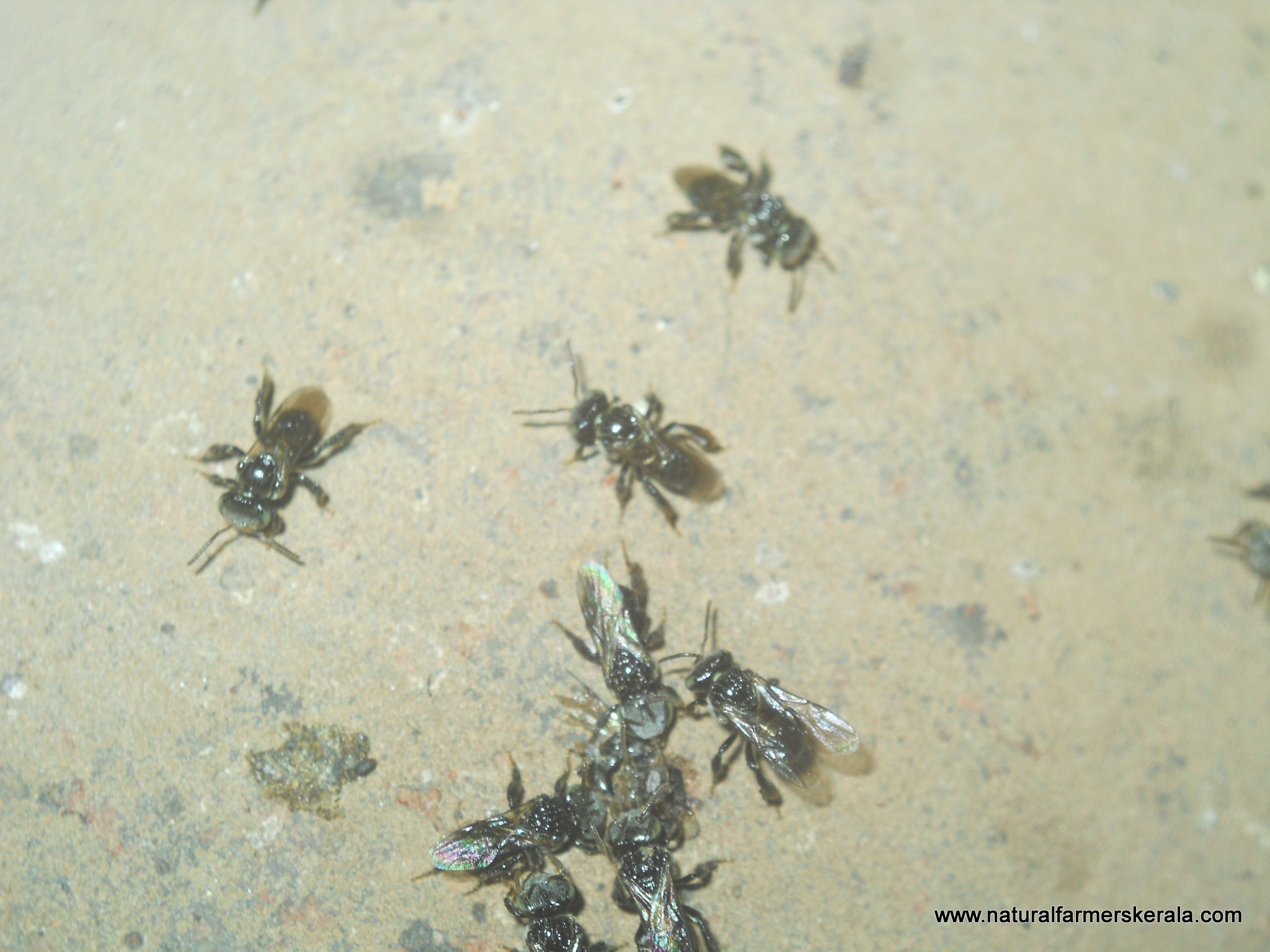Stingless Honey Bee(Dwarf Honey Bees) or Cheruthen Eecha

Stingless honey bees are found in most parts of the world. It some what varies in colour and appearance. One thing common among them is they are all small not bigger than 5mm and they have no stinger. In Kerala we call it cheruthen eecha, it is 3mm in size. This species is know as trigona iridipennis.

Did the bigger bees develop stinger or stingless bees lose their stinger??? How does it matter; stingless bees effectively defend their colony by trapping ants and other pest with propolis or plant resin, biting, even with humans they use propolis along with biting on eyelids and crawling inside the nose and ears.
Stingless bee honey in India

Kerala Stingless Bee Honey (Cheruthen – Small bee Honey)
Many people buy honey of bigger bees regularly however they are not willing to keep them in their farm or garden because of the aggressive nature. For such people and farmers stingless honey bee is the best option. Stingless Beekeeping is know as “meliponiculture”. Only drawback is they produce less honey. On a average a bee colony can provide some where around 200 grams to 1 kg of honey in a year. This also depends on how big the colony is and nectar available locally. However some farmers have been able to get 2 to 3 kg from healthy colony once in a while.
Cheruthen(Stingless bees honey) is considered superior honey in Ayurvedic texts and other medical journals. It is mostly administered to kids for mild fever. This honey helps to reduce fever and treat many kind of infections. I don’t have a supporting document here. However I can guess why it has the ability to reduce fever(Stingless bees feed on thumba-poo which is antipyretic, anti fungal anti-microbial etc. for more details on thumba read this Leucas aspera). There are many more medicinal plants that this bees feed. Not just in India. Africans, Australians, most part of tropical area and South Americans consider this honey as medicine.
Unique Manuka factor(UMF) is a term used for honey produced from manuka tree flowers which has high antimicrobial properties. Somehow I feel the honey collect from here in Kerala is superior to honey with the maximum UMF. Because there are a lot of medicinal herbs here in Kerala that this bees feed on.
Honey is not just used internally, it can be successfully used to heal a water oozing wound. It is largely because of the hydrogen peroxide, antifungal activity, rich in antioxidant, antimicrobial that helps heal a wound. If a wound is left untreated it oozes liquid, this happen sometime even after applying antibiotic ointments, when natural raw honey is applied there will be no sign of fluid and healing is much faster, I have tried it. It does a excellent work.
Cheruthen is considered medicinal because it collects nectar and pollen from small wild growing plants and trees, it is difficult for bigger bees to get inside smaller flowers. Bigger bees are mostly circulated in fruit orchards, where all sorts of chemicals and hormones are used for production. How can that honey be medicine or consumed???
Have been noticing these small bees like coco palm tree (theng) flowers. It has very less nectar but lots and lots of pollen. It reminds me in olden days people used scraping of tender coconut leaf which has a ashy coating for wound dressing. It has anti-microbial quality. Even virgin coconut oil has the same qualities. So pollen and nectar should definitely have the same qualities.
Stingless bees largely feed on coco palm, banana, guava, papaya, mango, tamarind, thumbapoo, Communist pacha, touch-me-not plant (thottavadi), jackfruit tree, Tulsi (Holy Basil), kulir mavu, teak for honey, pollen and resin. Note in the forest it will have much more variety.
Benefit of keeping at-least one colony of stingless bees in your farm is you can extract honey anytime of the year, there will be always little honey.
Stingless bees store honey in small pots made of wax and propolis(resin extracted from tree buds and sap that flows from trees. It looks like bunch of grapes.
They consume and also feed very little honey for their young ones as compared to larger bees. They seal and preserve excess honey and start building new honey chamber if there is space. Even during non flowering season they are active and raising new ones. Unlike larger bees stingless bees lay eggs and store pollen and honey just once till they emerge as bees. In most cases more than 70 percent of bees with queen leave the colony for a new location if space is a constraint.
Major Difference between Sting-less Bee Honey and Larger Bee Honey
- Stingless bee honey is not overly sweet and has a pleasant taste and aroma. Larger bee honey is overly sweet.
- Stingless bee honey is medicinal because of the flowers and trees it visits.
- Stingless bees don’t mix pollen with honey. Most people who have seen the nest misunderstand that pollen is the hardened form of old honey. It will have a little honey pot here and there in the pollen storage bunch. Pollen will always be close to the entry of the bees colony. Larger bees mix honey and pollen together know as bee bread.
- Stingless bees wax is not white or off white in colour. It has a golden texture when melted and filtered. Raw form of wax may be dark brown, green, black in colour depending on the local available tree resin.
- Stingless bee honey has more water content as compared to larger bees. If not take care it will spoil in room temperature. Traditionally people added two or three white pepper seeds to preserve it.
- Stingless bee’s honey is mostly in shades of amber colour. Larger bees honey comes in many variety of colours.
How to Extract or Transfer Stingless Bee Colony
- Before proceeding ahead word of caution. Never expose a colony during night. Everything has to happen preferably during morning hours.
- If you are transferring a bee colony from one place to another. This should happen during night after sunset by then all the bee would have settled in the hive.
- If you are extracting honey or transferring the colony to a new hive. It is always good to used a clean plastic bottle with small ventilation to trap the bees from the entry by hitting at the back of the hive with your hands and placing the bottle mouth at the bee entry spot. Most of the attackers will come out immediately. Now just close the bottle lid and let them rest while you do your work.
- Bamboo Beehive – This bees like hollow tree trunks and sealed cavities. So bamboo is the best substitute while transferring them to new location. Split open a Bamboo in two halves as shown in the below image.
- Most of the bee colony is difficult to extract, their entry is always small, less than 1 cm. If you can break open. Make sure you get all the eggs and larvae in the box.
- If you are unable to reach the colony. Use a flower pot and make a small opening at the bottom. Now you can attach the mud vessel to the entry binding it with cement and mud with some support for few days. Now apply the propolis(sticky stuff found on the entry of the colony/ check the below image) to the mud vessel opening. Bees recognize their colony with the smell of propolis at the entry. Now wait for a minimum of six months for the bees to transfer or build a new colony in the vessel.
- Don’t have patience then go a head and break open the colony and transfer the bees, honey, pollen, eggs and propolis. Make sure you keep the new colony near by the old one till sunset because many bees would be out for gathering honey and pollen. When it is dark you can transfer them to a new location.
- New place has to be elevated from the ground. Keep away and watch out for ants. Hanging the hive on trees or other place using ropes also don’t work. Bigger and small ants are a big problem. Best option is keep the colony on a table and immerse the leg of the table in water(best way to keep ants away). Ideally I believe colony should be kept on this table for coming 2 to 3 months. By this time the colony would have established itself and the entry would be sealed which should keep ants and other pest away in future.
Credits & References
- Indian stingless bee / Tetragonula iridipennis – https://en.wikipedia.org/wiki/Tetragonula_iridipennis
- Thumba / Leucas aspera – https://en.wikipedia.org/wiki/Leucas_aspera
- Thotta vadi / Mimos pudica / Touch me not – http://en.wikipedia.org/wiki/Mimosa_pudica
- Image credit – http://www.flickr.com/photos/ranjithsiji/
108 Replies to “Stingless Honey Bee(Dwarf Honey Bees) or Cheruthen Eecha”
Comments are closed.











Hi,
I am trying to transfer some small bee colonies from masonry foundation of a house. I have attached terracotta pots with a small hole to the colony entrance. How long it will take to transfer the colony to the pot? The bees have made entrance with their wax at the hole on the pot
Would like to try bee keeping. can anybody guide.
I want to know where i could buy cherutheen , nera muvattupuzha , please send me adress or phone number
————————
Send you PM
hi….
Could you pls give an idea on when is the right time to split the colony ? I have three colony. Is it compulsory to check whether queen bee is present in both the colonies ?
Two of the colony i have is in bigger box that of bigger bee. Also the size of the colony is big. So can i split the same into three ? Pls guide.
———–
Hello Sreejith,
January month is the best. So the new colony still has time to establish itself. If done late during summer months its litle difficult to get honey and in rainy season you stand the chance of losing the new colony.
No need of queen in the new colony , they are well advanced and will develop a queen in few days time. Just place few eggs in the new hive, that’s all, say your palm size. yes if you have sufficient eggs then go a head. note eggs are white in color and larvae will be a darker shade.
Hope this helps. Lets me know if you need more info.
Thanks alot for the information. Also need to know whether after splitting the colony, can the new and old be kept side by side.
——————–
Sorry for delay.
No no. Just after splitting the colony old one should be moved to a new location say after 4 to 5 hours. so the new one will have eggs and some bees. And few from the old colony may also get into the new colony giving more strength. Some prefer the other way. Please do this during day time morning.
If kept in the same place. Chances are all bees will get back into old colony and when new ones take birth from the eggs also will move to the old colony. I say this coz I have experienced it.
thanks for the nice piece of advice…..it was really helpful….